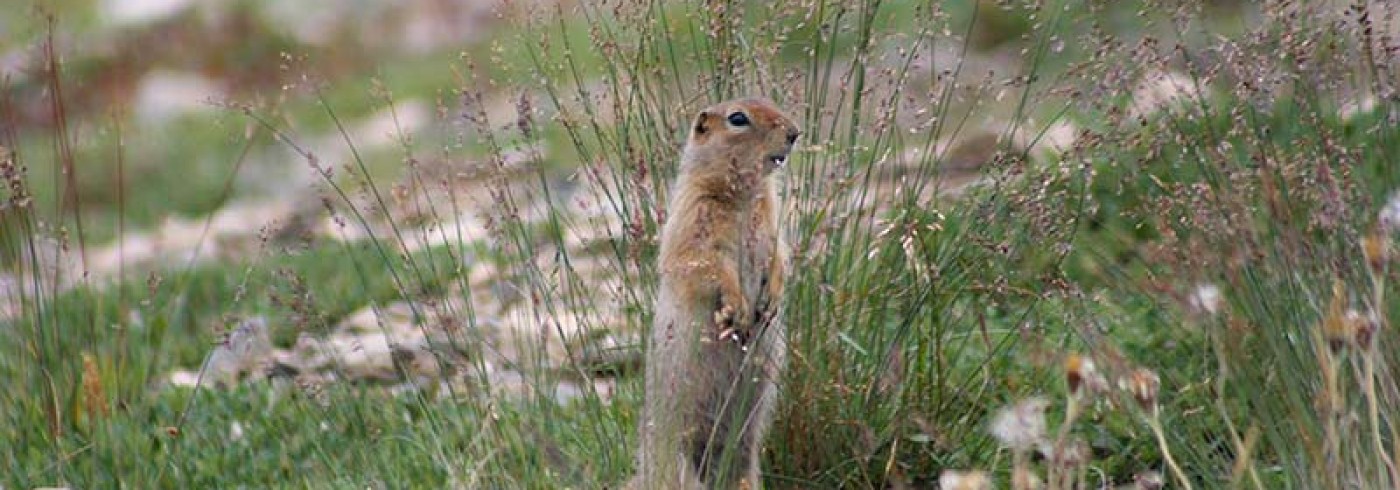Expedition summary: Tundra Northwest – interactions between plants, herbivores and predators
Compared to biomes in more southerly latitudes, there is little fauna and flora diversity on the tundra. Furthermore, the structure of ecological communities is relatively simple in the Arctic. This provides an ideal opportunity for studies on the interaction between organisms on different trophic levels and within the same level. Integrated studies of plants, herbivores and predators are of great scientific importance because they enhance our understanding of community mechanisms in general, and provide valuable information for the management of natural resources in the Arctic.
Important forage plants for herbivores are to be found among all major life forms of tundra plants, i.e. mosses, lichens, graminoids, dwarf and low shrubs, and herbs. The major terrestrial herbivores are lemmings, caribou, musk-oxen, geese, and some herbivorous insects. The vertebrate herbivores are preyed upon by a few species of avian predators and mammalian carnivores ranging in size from small mustelids to polar bears. However, it is lemmings that seem to play a major role in many tundra ecosystems. During peak years they make a great impact on the vegetation, but also constitute an important food resource for predators.
There have been several field-studies on tundra plants, herbivores and carnivores, but due to logistic difficulties few of them have simultaneously analysed the relationship between plants, herbivores and predators. Although some important scientific contributions have been made in the past, Tundra Northwest 1999 made it possible to collect information from as many as 17 sites on the Nearctic tundra in a single summer.
The aim
The overall aim of Theme A – interactions between plants, herbivores and predators, was therefore to study the organization of the terrestrial community in Arctic Canada and to compare the results with knowledge gained during the Swedish-Russian Tundra Ecology Expedition 1994. The key questions were: Are the tundra communities organized top-down by predators or bottom-up by plants? Or will lemmings generate cascade effects throughout the Arctic ecosystem?
Our general study of trophic dynamics
In addition to the more detailed projects reported below, Theme A as a group performed studies directly targeted at the overall aim. The study on trophic interactions was based on the expertise of the participants and was planned in several group discussions. All Theme A members helped with the field-work in good spirit. Our aim was to collect representative data about the standing crop of plants, the densities of herbivores and predators, and the food-web structure for each of the sites visited.
In order to estimate the standing crop of the main plant groups on the landscape scale we first calculated the coverage of the main vegetation types by using digital aerial photos taken from a helicopter. These were analysed just as soon as they were taken aboard the ship. Furthermore, we estimated the plant cover and the above ground standing crop of the main plant groups in quadrats spread over our study area. We also collected plant samples for analyses of protein, fibre and defence compounds.
For the purpose of estimating herbivore density we also used a set of different standard methods. Densities of small mammals, especially lemmings, were estimated by systematic trapping and counts of winter nests. Densities of musk-oxen, caribou, geese, ptarmigan were determined by turd counts in transect lines and in addition, by aerial surveys from helicopter. The abundance and biomass of insect herbivores were also estimated at some of the sites. Mammalian (e.g. foxes and wolves) and avian predators (e.g. raptors and skuas) were surveyed from helicopter and by means of line transects from the ground.
For the studies on the trophic dynamics of the tundra communities we also needed information on the food-web structure. For this purpose we collected various remains left by predators. Detailed analysis of this material has already started.
We plan to use the information collected for joint synthesis and model work on the trophic dynamics of tundra communities in the Canadian Arctic. We had the opportunity to cover a wide area of primary productivity, e.g. from the barren Ellef Ringnes Island to the productive lvvavik National Park on the mainland and to collect information on plants, herbivores and predators according to a common protocol at many sites. Therefore, we are optimistic about the possibility of answering the question: What becomes of primary productivity in the Canadian Arctic?
Dates
June–September 1999
Participants
Cheif scientist
Anders Angerbjörn
Department of Zoology, Stockholm University
Sweden
Cheif scientist
Kjell Danell
Department of Animal Ecology, Swedish University of Agricultural Sciences
Umeå, Sweden
Principal investigator
Jep Agrell
Department of Animal Ecology, Lund University
Sweden
Principal investigator
Dominique Berteaux
Department of Natural Resources and Sciences, McGill University
Sainte-Anne-de-Bellevue, Canada
Principal investigator
KariAnne Bråthen
Institute for Biology, University of Tromsö
Norway
Principal investigator
Öje Danell
Department of Animal Breeding and Genetics, Swedish University of Agricultural Sciences
Uppsala, Sweden
Principal investigator
Sam Erlinge
Department of Ecology, Lund University
Sweden
Principal investigator
Joakim Hjälten
Department of Animal Ecology, Swedish University of Agricultural Sciences
Umeå, Sweden
Principal investigator
Göran Högstedt
Institute of Zoology, University of Bergen
Norway
Principal investigator
Ingibjörg S. Jónsdóttir
Botanical Institute, University of Gothenburg
Sweden
Principal investigator
Nils Kjellén
Department of Animal Ecology, Lund University
Sweden
Principal investigator
Magnus Tannerfeldt
Department of Zoology, Stockholm University
Sweden
Principal investigator
Christer G. Wiklund
Department of Zoology, University of Gothenburg
Sweden
Alice Kenney
Department of Zoology, University of British Columbia
Vancouver, Canada
Nils Kjellén
Department of Ecology, Lund University
Sweden
Charles J. Krebs
Department of Zoology, University of British Columbia
Vancouver, Canada
Åke Lindström
Department of Ecology, Lund University
Sweden
Torgny Nordin
Department of Philosophy, University of Gothenburg
Sweden
Carolyn Parker
Herbarium of University of Alaska
Fairbanks, USA
Heikki Roininen
Department of Biology, University of Joensuu
Finland
Mikael Svensson
Department of Ecology, Lund University
Sweden
Susanne Åkesson
Department of Ecology, Lund University
Sweden

